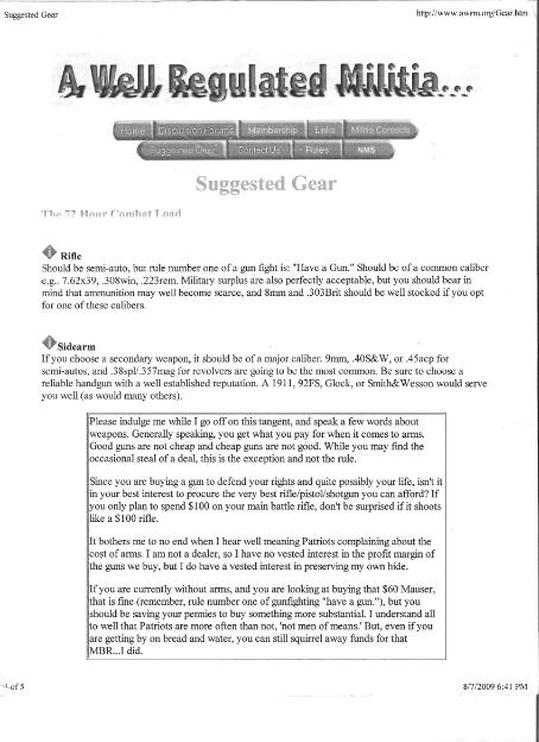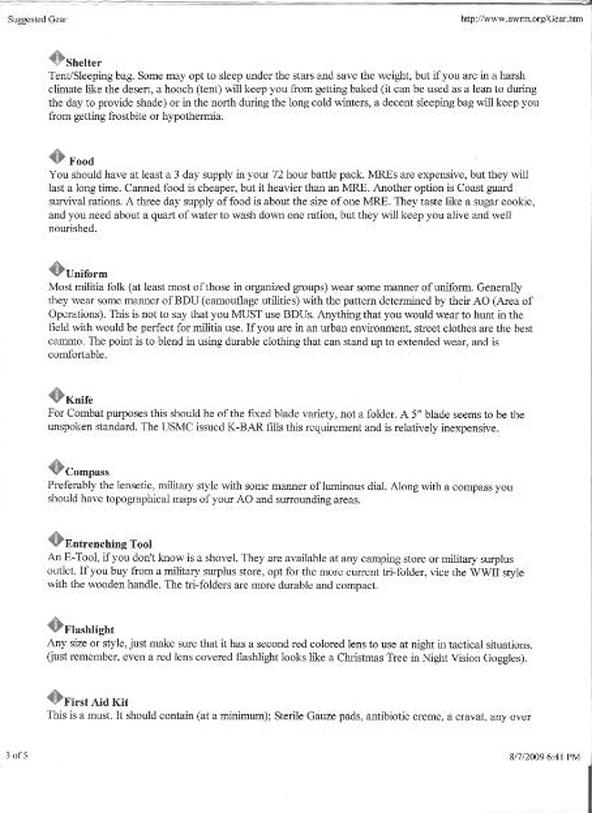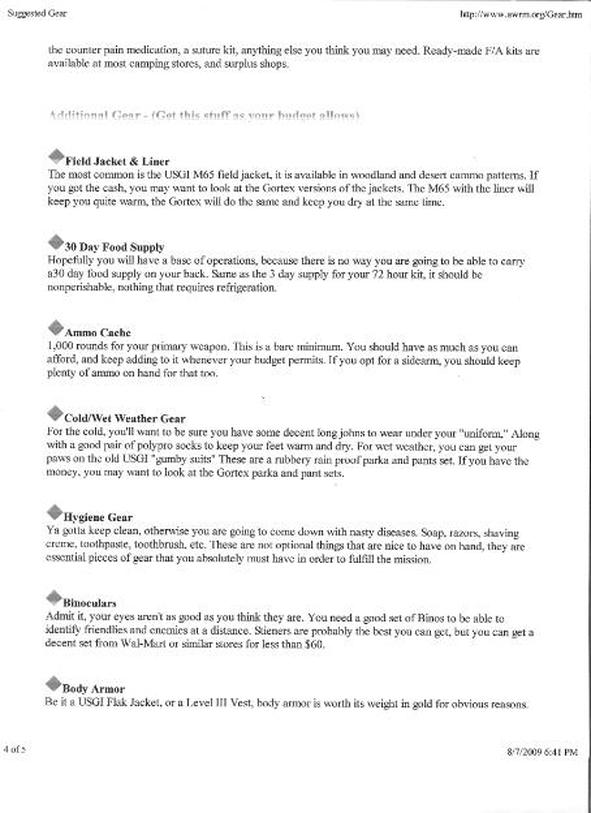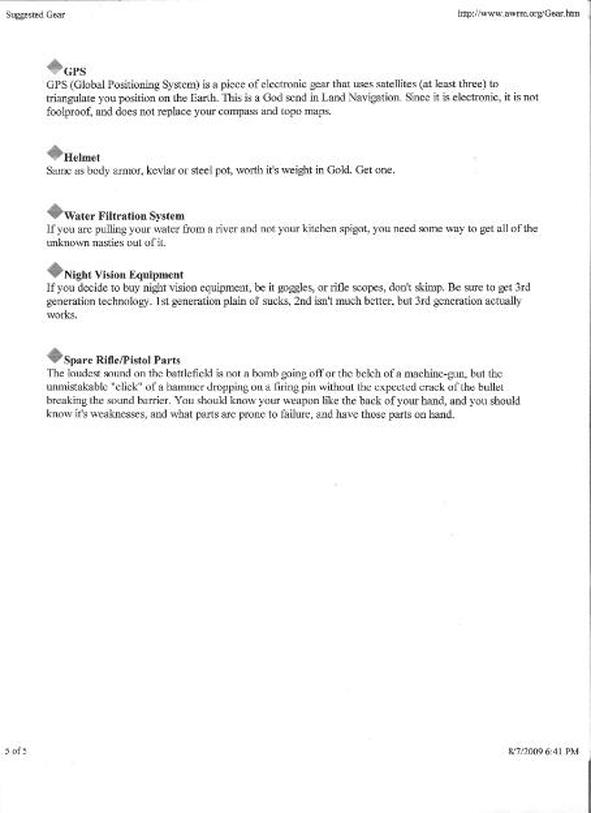The below equipment list is not all inclusive. There are many lists, this one seems to be the most complete . We use this list as guideline for the Militiaman or woman to equipment themselves which must be done as fast possible. Some of the items listed are optional . upgraded equipment list located below notice in the first list load bearing equipment was missing . This list is courtesy of www.awrm.org
The 72 Hour Combat Load
Rifle
Should be semi-auto, but rule number one of a gun fight is: "Have a Gun." Should be of a common caliber e.g.. 7.62x39, .308win, .223rem. Military surplus are also perfectly acceptable, but you should bear in mind that ammunition may well become scarce, and 8mm and .303Brit should be well stocked if you opt for one of these calibers.
Sidearm
If you choose a secondary weapon, it should be of a major caliber. 9mm, .40S&W, or .45acp for semi-autos, and .38spl/.357mag for revolvers are going to be the most common. Be sure to choose a reliable handgun with a well established reputation. A 1911, 92FS, Glock, or Smith&Wesson would serve you well (as would many others).
Please indulge me while I go off on this tangent, and speak a few words about weapons. Generally speaking, you get what you pay for when it comes to arms. Good guns are not cheap and cheap guns are not good. While you may find the occasional steal of a deal, this is the exception and not the rule.
Since you are buying a gun to defend your rights and quite possibly your life, isn't it in your best interest to procure the very best rifle/pistol/shotgun you can afford? If you only plan to spend $100 on your main battle rifle, don't be surprised if it shoots like a $100 rifle.
It bothers me to no end when I hear well meaning Patriots complaining about the cost of arms. I am not a dealer, so I have no vested interest in the profit margin of the guns we buy, but I do have a vested interest in preserving my own hide.
If you are currently without arms, and you are looking at buying that $60 Mauser, that is fine (remember, rule number one of gunfighting "have a gun."), but you should be saving your pennies to buy something more substantial. I understand all to well that Patriots are more often than not, 'not men of means.' But, even if you are getting by on bread and water, you can still squirrel away funds for that MBR...I did.
Ammunition
You should carry as much ammunition as you can comfortably carry. Obviously, weight will be a concern, and while .308win has more punch than .223rem, you will not be able to carry as much of it. Most folks will carry about 200-300 rounds on their combat load. A bare minimum of 1,000 rounds should be on hand. If you opt for a sidearm, you should have at least 3-5 magazines (or speedloaders) for your sidearm in your 72 hour kit.
(On hand means not taken out and shot up unless it is being immediately replaced)
Weapons Cleaning Gear
For obvious reasons. If you don't keep it clean, it ain't gonna work.
LBE
(Load Bearing Equipment)
LBE is what you use to carry your stuff. It is not your pack. Generally it will consist of a belt with suspenders, and you will attach your canteens, magazine pouches/ammo bandoliers, first aid kits, sidearm, etc. Most folks opt for the USGI issued cartridge belt and H/Y Harness or the USGI load bearing vest. There are a multitude of different types of vests, harnesses, and the like (too many to list here). Basically, you need something to carry the gear that you need to have immediately on hand and still keep your hands free. One excellent resource for LBE is Stubby Gear.
Pack
You may well be on the move for a while, so you will need to have something to keep your equipment (that isn't on your LBE) in. Most folks use the USGI A.L.I.C.E. (All Purpose Individual Carrying Equipment) pack or the new MOLLE pack. A simple book bag will work in a pinch. Stubby Gear also has several excellent packs.
Boots
Be good to your feet and they'll be good to you. Uncle Sugar spends millions of dollars to figure out what boot is best (for the smallest amount of money) for his soldiers. He knows full well that if his fighters feet are fubar (say that 3 times fast) they simply can't fight. Having said that, any boot worn by our combat troops will be more than sufficient. Don't expect to last very long if you plan to fight in a pair of sneakers. Go get a good pair of boots, and don't skimp.
Water
Without it, you'll go tits up and die, it is that simple. You'll need something to carry it in. USGI canteens can be had for less than $5 each, but they only hold 1 quart, and you can normally fit two of them on your LBE along with all of your other goodies. There are also hydration packs available (Camel Backs). These can be had in a variety of capacities. I have seen them available in sizes up to 72 ounces.
Shelter
Tent/Sleeping bag. Some may opt to sleep under the stars and save the weight, but if you are in a harsh climate like the desert, a hooch (tent) will keep you from getting baked (it can be used as a lean to during the day to provide shade) or in the north during the long cold winters, a decent sleeping bag will keep you from getting frostbite or hypothermia.
Food
You should have at least a 3 day supply in your 72 hour battle pack. MREs are expensive, but they will last a long time. Canned food is cheaper, but it heavier than an MRE. Another option is Coast guard survival rations. A three day supply of food is about the size of one MRE. They taste like a sugar cookie, and you need about a quart of water to wash down one ration, but they will keep you alive and well nourished.
Uniform
Most militia folk (at least most of those in organized groups) wear some manner of uniform. Generally they wear some manner of BDU (camouflage utilities) with the pattern determined by their AO (Area of Operations). This is not to say that you MUST use BDUs. Anything that you would wear to hunt in the field with would be perfect for militia use. If you are in an urban environment, street clothes are the best cammo. The point is to blend in using durable clothing that can stand up to extended wear, and is comfortable.
Knife
For Combat purposes this should be of the fixed blade variety, not a folder. A 5" blade seems to be the unspoken standard. The USMC issued K-BAR fills this requirement and is relatively inexpensive.
Compass
Preferably the lensetic, military style with some manner of luminous dial. Along with a compass you should have topographical maps of your AO and surrounding areas.
Entrenching Tool
An E-Tool, if you don't know is a shovel. They are available at any camping store or military surplus outlet. If you buy from a military surplus store, opt for the more current tri-folder, vice the WWII style with the wooden handle. The tri-folders are more durable and compact.
Flashlight
Any size or style, just make sure that it has a second red colored lens to use at night in tactical situations. (just remember, even a red lens covered flashlight looks like a Christmas Tree in Night Vision Goggles).
First Aid Kit
This is a must. It should contain (at a minimum); Sterile Gauze pads, antibiotic creme, a cravat, any over the counter pain medication, a suture kit, anything else you think you may need. Ready-made F/A kits are available at most camping stores, and surplus shops.
Additional Gear - (Get this stuff as your budget allows)
Field Jacket & Liner
The most common is the USGI M65 field jacket, it is available in woodland and desert cammo patterns. If you got the cash, you may want to look at the Gortex versions of the jackets. The M65 with the liner will keep you quite warm, the Gortex will do the same and keep you dry at the same time.
30 Day Food Supply
Hopefully you will have a base of operations, because there is no way you are going to be able to carry a30 day food supply on your back. Same as the 3 day supply for your 72 hour kit, it should be nonperishable, nothing that requires refrigeration.
Ammo Cache
1,000 rounds for your primary weapon. This is a bare minimum. You should have as much as you can afford, and keep adding to it whenever your budget permits. If you opt for a sidearm, you should keep plenty of ammo on hand for that too.
Cold/Wet Weather Gear
For the cold, you'll want to be sure you have some decent long johns to wear under your "uniform," Along with a good pair of polypro socks to keep your feet warm and dry. For wet weather, you can get your paws on the old USGI "gumby suits" These are a rubbery rain proof parka and pants set. If you have the money, you may want to look at the Gortex parka and pant sets.
Hygiene Gear
Ya gotta keep clean, otherwise you are going to come down with nasty diseases. Soap, razors, shaving creme, toothpaste, toothbrush, etc. These are not optional things that are nice to have on hand, they are essential pieces of gear that you absolutely must have in order to fulfill the mission.
Binoculars
Admit it, your eyes aren't as good as you think they are. You need a good set of Binos to be able to identify friendlies and enemies at a distance. Stieners are probably the best you can get, but you can get a decent set from Wal-Mart or similar stores for less than $60.
Body Armor
Be it a USGI Flak Jacket, or a Level III Vest, body armor is worth its weight in gold for obvious reasons.
GPS
GPS (Global Positioning System) is a piece of electronic gear that uses satellites (at least three) to triangulate you position on the Earth. This is a God send in Land Navigation. Since it is electronic, it is not foolproof, and does not replace your compass and topo maps.
Helmet
Same as body armor, kevlar or steel pot, worth it's weight in Gold. Get one.
Water Filtration System
If you are pulling your water from a river and not your kitchen spigot, you need some way to get all of the unknown nasties out of it.
Night Vision Equipment
If you decide to buy night vision equipment, be it goggles, or rifle scopes, don't skimp. Be sure to get 3rd generation technology. 1st generation plain ol' sucks, 2nd isn't much better, but 3rd generation actually works.
Spare Rifle/Pistol Parts
The loudest sound on the battlefield is not a bomb going off or the belch of a machine-gun, but the unmistakable "click" of a hammer dropping on a firing pin without the expected crack of the bullet breaking the sound barrier. You should know your weapon like the back of your hand, and you should know it's weaknesses, and what parts are prone to failure, and have those parts on hand.
Rifle
Should be semi-auto, but rule number one of a gun fight is: "Have a Gun." Should be of a common caliber e.g.. 7.62x39, .308win, .223rem. Military surplus are also perfectly acceptable, but you should bear in mind that ammunition may well become scarce, and 8mm and .303Brit should be well stocked if you opt for one of these calibers.
Sidearm
If you choose a secondary weapon, it should be of a major caliber. 9mm, .40S&W, or .45acp for semi-autos, and .38spl/.357mag for revolvers are going to be the most common. Be sure to choose a reliable handgun with a well established reputation. A 1911, 92FS, Glock, or Smith&Wesson would serve you well (as would many others).
Please indulge me while I go off on this tangent, and speak a few words about weapons. Generally speaking, you get what you pay for when it comes to arms. Good guns are not cheap and cheap guns are not good. While you may find the occasional steal of a deal, this is the exception and not the rule.
Since you are buying a gun to defend your rights and quite possibly your life, isn't it in your best interest to procure the very best rifle/pistol/shotgun you can afford? If you only plan to spend $100 on your main battle rifle, don't be surprised if it shoots like a $100 rifle.
It bothers me to no end when I hear well meaning Patriots complaining about the cost of arms. I am not a dealer, so I have no vested interest in the profit margin of the guns we buy, but I do have a vested interest in preserving my own hide.
If you are currently without arms, and you are looking at buying that $60 Mauser, that is fine (remember, rule number one of gunfighting "have a gun."), but you should be saving your pennies to buy something more substantial. I understand all to well that Patriots are more often than not, 'not men of means.' But, even if you are getting by on bread and water, you can still squirrel away funds for that MBR...I did.
Ammunition
You should carry as much ammunition as you can comfortably carry. Obviously, weight will be a concern, and while .308win has more punch than .223rem, you will not be able to carry as much of it. Most folks will carry about 200-300 rounds on their combat load. A bare minimum of 1,000 rounds should be on hand. If you opt for a sidearm, you should have at least 3-5 magazines (or speedloaders) for your sidearm in your 72 hour kit.
(On hand means not taken out and shot up unless it is being immediately replaced)
Weapons Cleaning Gear
For obvious reasons. If you don't keep it clean, it ain't gonna work.
LBE
(Load Bearing Equipment)
LBE is what you use to carry your stuff. It is not your pack. Generally it will consist of a belt with suspenders, and you will attach your canteens, magazine pouches/ammo bandoliers, first aid kits, sidearm, etc. Most folks opt for the USGI issued cartridge belt and H/Y Harness or the USGI load bearing vest. There are a multitude of different types of vests, harnesses, and the like (too many to list here). Basically, you need something to carry the gear that you need to have immediately on hand and still keep your hands free. One excellent resource for LBE is Stubby Gear.
Pack
You may well be on the move for a while, so you will need to have something to keep your equipment (that isn't on your LBE) in. Most folks use the USGI A.L.I.C.E. (All Purpose Individual Carrying Equipment) pack or the new MOLLE pack. A simple book bag will work in a pinch. Stubby Gear also has several excellent packs.
Boots
Be good to your feet and they'll be good to you. Uncle Sugar spends millions of dollars to figure out what boot is best (for the smallest amount of money) for his soldiers. He knows full well that if his fighters feet are fubar (say that 3 times fast) they simply can't fight. Having said that, any boot worn by our combat troops will be more than sufficient. Don't expect to last very long if you plan to fight in a pair of sneakers. Go get a good pair of boots, and don't skimp.
Water
Without it, you'll go tits up and die, it is that simple. You'll need something to carry it in. USGI canteens can be had for less than $5 each, but they only hold 1 quart, and you can normally fit two of them on your LBE along with all of your other goodies. There are also hydration packs available (Camel Backs). These can be had in a variety of capacities. I have seen them available in sizes up to 72 ounces.
Shelter
Tent/Sleeping bag. Some may opt to sleep under the stars and save the weight, but if you are in a harsh climate like the desert, a hooch (tent) will keep you from getting baked (it can be used as a lean to during the day to provide shade) or in the north during the long cold winters, a decent sleeping bag will keep you from getting frostbite or hypothermia.
Food
You should have at least a 3 day supply in your 72 hour battle pack. MREs are expensive, but they will last a long time. Canned food is cheaper, but it heavier than an MRE. Another option is Coast guard survival rations. A three day supply of food is about the size of one MRE. They taste like a sugar cookie, and you need about a quart of water to wash down one ration, but they will keep you alive and well nourished.
Uniform
Most militia folk (at least most of those in organized groups) wear some manner of uniform. Generally they wear some manner of BDU (camouflage utilities) with the pattern determined by their AO (Area of Operations). This is not to say that you MUST use BDUs. Anything that you would wear to hunt in the field with would be perfect for militia use. If you are in an urban environment, street clothes are the best cammo. The point is to blend in using durable clothing that can stand up to extended wear, and is comfortable.
Knife
For Combat purposes this should be of the fixed blade variety, not a folder. A 5" blade seems to be the unspoken standard. The USMC issued K-BAR fills this requirement and is relatively inexpensive.
Compass
Preferably the lensetic, military style with some manner of luminous dial. Along with a compass you should have topographical maps of your AO and surrounding areas.
Entrenching Tool
An E-Tool, if you don't know is a shovel. They are available at any camping store or military surplus outlet. If you buy from a military surplus store, opt for the more current tri-folder, vice the WWII style with the wooden handle. The tri-folders are more durable and compact.
Flashlight
Any size or style, just make sure that it has a second red colored lens to use at night in tactical situations. (just remember, even a red lens covered flashlight looks like a Christmas Tree in Night Vision Goggles).
First Aid Kit
This is a must. It should contain (at a minimum); Sterile Gauze pads, antibiotic creme, a cravat, any over the counter pain medication, a suture kit, anything else you think you may need. Ready-made F/A kits are available at most camping stores, and surplus shops.
Additional Gear - (Get this stuff as your budget allows)
Field Jacket & Liner
The most common is the USGI M65 field jacket, it is available in woodland and desert cammo patterns. If you got the cash, you may want to look at the Gortex versions of the jackets. The M65 with the liner will keep you quite warm, the Gortex will do the same and keep you dry at the same time.
30 Day Food Supply
Hopefully you will have a base of operations, because there is no way you are going to be able to carry a30 day food supply on your back. Same as the 3 day supply for your 72 hour kit, it should be nonperishable, nothing that requires refrigeration.
Ammo Cache
1,000 rounds for your primary weapon. This is a bare minimum. You should have as much as you can afford, and keep adding to it whenever your budget permits. If you opt for a sidearm, you should keep plenty of ammo on hand for that too.
Cold/Wet Weather Gear
For the cold, you'll want to be sure you have some decent long johns to wear under your "uniform," Along with a good pair of polypro socks to keep your feet warm and dry. For wet weather, you can get your paws on the old USGI "gumby suits" These are a rubbery rain proof parka and pants set. If you have the money, you may want to look at the Gortex parka and pant sets.
Hygiene Gear
Ya gotta keep clean, otherwise you are going to come down with nasty diseases. Soap, razors, shaving creme, toothpaste, toothbrush, etc. These are not optional things that are nice to have on hand, they are essential pieces of gear that you absolutely must have in order to fulfill the mission.
Binoculars
Admit it, your eyes aren't as good as you think they are. You need a good set of Binos to be able to identify friendlies and enemies at a distance. Stieners are probably the best you can get, but you can get a decent set from Wal-Mart or similar stores for less than $60.
Body Armor
Be it a USGI Flak Jacket, or a Level III Vest, body armor is worth its weight in gold for obvious reasons.
GPS
GPS (Global Positioning System) is a piece of electronic gear that uses satellites (at least three) to triangulate you position on the Earth. This is a God send in Land Navigation. Since it is electronic, it is not foolproof, and does not replace your compass and topo maps.
Helmet
Same as body armor, kevlar or steel pot, worth it's weight in Gold. Get one.
Water Filtration System
If you are pulling your water from a river and not your kitchen spigot, you need some way to get all of the unknown nasties out of it.
Night Vision Equipment
If you decide to buy night vision equipment, be it goggles, or rifle scopes, don't skimp. Be sure to get 3rd generation technology. 1st generation plain ol' sucks, 2nd isn't much better, but 3rd generation actually works.
Spare Rifle/Pistol Parts
The loudest sound on the battlefield is not a bomb going off or the belch of a machine-gun, but the unmistakable "click" of a hammer dropping on a firing pin without the expected crack of the bullet breaking the sound barrier. You should know your weapon like the back of your hand, and you should know it's weaknesses, and what parts are prone to failure, and have those parts on hand.




